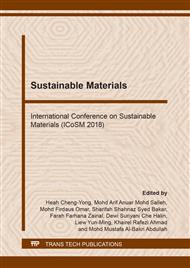p.346
p.353
p.361
p.368
p.374
p.385
p.393
p.399
p.410
Oil and Water Absorption Behavior of TPU/Natural Fibers Composites
Abstract:
Fruit skins are waste and natural fibers which are processed from it can be used as filler material in polymer composites. These natural fibers are surely inexpensive, non-toxic and environmentally friendly. In the other hand, natural fibers are chemically hydrophilic and absorb water. Their nature which are rich cellulose making it hydrophilic in nature. Besides their nature to water, the ability of natural fibers to absorb oil also interesting to be studied. In this paper, natural fibers from several types of fruit skin were used as filler in thermoplastic polyurethane (TPU) composites. The fibers from pineapple skin, coconut shell, coconut husk, corn cob, rambutan, mangoesteen and banana with the percentage of 15% and 20% were incorporated with TPU through melt mixing technique. Every type of natural fiber will absorb oil and water at different rate, as well as the effect of filler content in the composite. Overall, the absorption of water and oil increased its percentage when the filler content increases. Rambutan, pineapple and banana absorb more water than others at 20% filler content in the TPU. Pineapple and rambutan also tend to absorb more engine oil.
Info:
Periodical:
Pages:
374-381
Citation:
Online since:
August 2018
Keywords:
Price:
Сopyright:
© 2018 Trans Tech Publications Ltd. All Rights Reserved
Share:
Citation:


